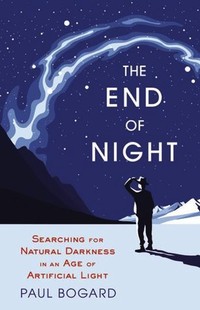Review: The End of Nightby Jeff Foust
|
| Instead of going from one to nine, the book’s chapters run from nine to one. Bogard makes use of what’s known as the Bortle Dark-Sky Scale, a one-to-nine classification of the darkness of the night sky. |
These artificial constellations may look pretty, but they have a serious downside as well: the fact that these lights are visible from space means that the people living in those cities are deprived of a view of the natural constellations of the night sky. Light pollution is becoming a more serious issue as cities get more, and brighter, lights, attempting, in essence, to abolish the night. The implications of light pollution extend beyond simply the inability to see many stars in the night sky to potentially significant psychological, physiological, and even philosophical issues, as explored by Paul Bogard in The End of Night.
One of the first things you’ll notice about Bogard’s book is the enumeration of the chapters: instead of going from one to nine, they run from nine to one. Bogard makes use of what’s known as the Bortle Dark-Sky Scale, a one-to-nine classification of the darkness of the night sky developed by astronomer John Bortle. A one is a very dark site (“an observer’s Nirvana!” Bortle wrote in a 2001 Sky & Telescope article) where even the Milky Way can cast shadows, while a nine is a bright inner city sky where only the brightest of stars can be seen. In The End of Night, Bogard starts in those bright city lights—the Las Vegas Strip—and makes it to some of the few remaining very dark sites in North America in the final chapter.
Along the way, Bogard travels across North America and Europe, looking not just at the visibility of the night sky but the history of artificial lighting of cities and the consequences of such lighting. More and brighter lighting is often defended on public safety grounds—by banishing darkness, proponents argue, they give criminals no place to hide—but there’s little evidence, he notes, of a correlation between increased lighting and decreased crime. People who work late shifts, exposed only to bright artificial lights, run increased risks of everything from obesity to, more controversially, cancer. And there is also the loss of connection to the night sky, with most people now living in cities and suburbs whose skies are so bright that the Milky Way is never visible.
| If we are ever going to protect the darkest places we have left, they will have to be dark places we actually know and visit, love and respect,” he writes. |
The End of Night is not without some hope, though. Bogard points to efforts or groups like the International Dark-Sky Association (IDA), which supports efforts like local ordinances to reduce light pollution in cities. Even for IDA success stories like Flagstaff, Arizona, which has strong measures in place to reduce light pollution, they have only reduced the rate of growth of overall illumination as the city grows overall. IDA also recognizes locations with particularly dark skies that make efforts to preserve them (one, Mont-Mégantic National Park in Quebec, calls itself in French “Réserve internationale de ciel étoile” or “International starry sky reserve,” which perhaps sounds more positive than the IDA’s designation of “dark sky reserve.”)
Near the end of the book, Bogard visits some of the few remaining sites with “Bortle class one” skies. The viewing (when not obscured by clouds or smoke from wildfires) is stunning, but these locations are difficult to get to—if they were easy, their skies would likely be not as dark. An alternative, he suggests, could be those national parks in parts of the country, particularly the Southwest, where skies are nearly as dark but are sites that are more accessible to the public. That fits into the overall mission of the National Park Service, he argues, of preserving nature for future generations. “If we are ever going to protect the darkest places we have left, they will have to be dark places we actually know and visit, love and respect,” he writes.
The End of Night serves as a complement to another recent work on light pollution, the 2011 documentary The City Dark (see “Review: The City Dark”, The Space Review, February 6, 2012.) The documentary can offer the visuals of the effects of light pollution on the night sky not possible in a book, while this book goes into a level of detail not possible in a 90-minute documentary. Both, though, offer a warning that society’s desire for more and brighter lights is not without astronomical and other consequences.
